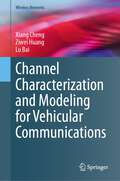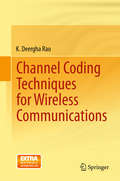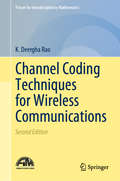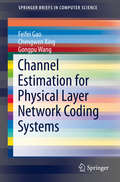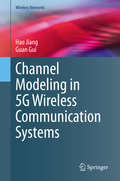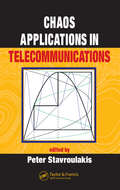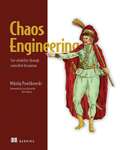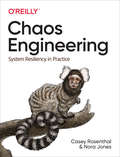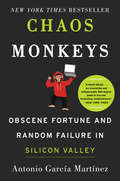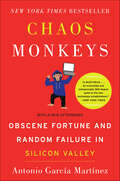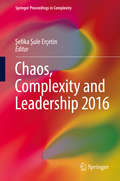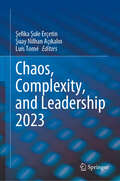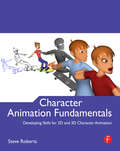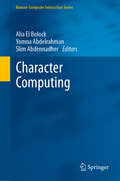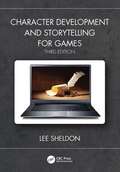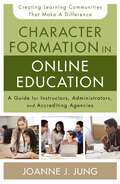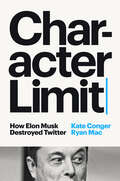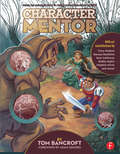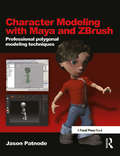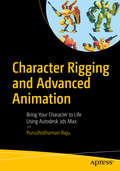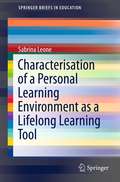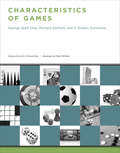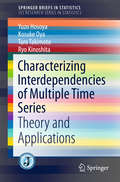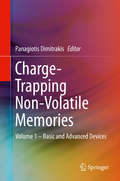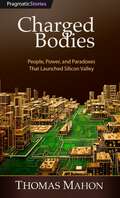- Table View
- List View
Channel Characterization and Modeling for Vehicular Communications (Wireless Networks)
by Xiang Cheng Ziwei Huang Lu BaiThis book presents and develops comprehensive knowledge of vehicular channel characteristics and proper vehicular channel models. The studied topics contain the propagation characteristics of vehicular communications, such as: a time-frequency non-stationary single-input single-output (SISO) vehicle-to-vehicle (V2V) non-geometry stochastic model (NGSM); a space-time non-stationary massive multiple-input multiple-output (MIMO) V2V regular-shaped geometry-based stochastic model (RS-GBSM); and a space-time non-stationary massive MIMO V2V irregular-shaped geometry-based stochastic model (IS-GBSM). Each is introduced, with characteristics then discussed in detail. Finally, this book discusses future research directions to inspire further investigation in the field of vehicular channels from three different perspectives.
Channel Coding Techniques for Wireless Communications
by K. Deergha RaoThe book discusses modern channel coding techniques for wireless communications such as turbo codes, low parity check codes (LDPC), space-time coding, Reed Solomon (RS) codes and convolutional codes. Many illustrative examples are included in each chapter for easy understanding of the coding techniques. The text is integrated with MATLAB-based programs to enhance the understanding of the subject's underlying theories. It includes current topics of increasing importance such as turbo codes, LDPC codes, LT codes, Raptor codes and space-time coding in detail, in addition to the traditional codes such as cyclic codes, BCH and RS codes and convolutional codes. MIMO communications is a multiple antenna technology, which is an effective method for high-speed or high-reliability wireless communications. PC-based MATLAB m-files for the illustrative examples are included and also provided on the accompanying CD, which will help students and researchers involved in advanced and current concepts in coding theory. Channel coding, the core of digital communication and data storage, has undergone a major revolution as a result of the rapid growth of mobile and wireless communications. The book is divided into 11 chapters. Assuming no prior knowledge in the field of channel coding, the opening chapters (1 - 2) begin with basic theory and discuss how to improve the performance of wireless communication channels using channel coding. Chapters 3 and 4 introduce Galois fields and present detailed coverage of BCH codes and Reed-Solomon codes. Chapters 5-7 introduce the family of convolutional codes, hard and soft-decision Viterbi algorithms, turbo codes, BCJR algorithm for turbo decoding and studies trellis coded modulation (TCM), turbo trellis coded modulation (TTCM), bit-interleaved coded modulation (BICM) as well as iterative BICM (BICM-ID) and compares them under various channel conditions. Chapters 8 and 9 focus on low-density parity-check (LDPC) codes, LT codes and Raptor codes. Chapters 10 and 11 discuss MIMO systems and space-time (ST) coding.
Channel Coding Techniques for Wireless Communications (Forum for Interdisciplinary Mathematics)
by K. Deergha RaoThis book discusses the latest channel coding techniques, MIMO systems, and 5G channel coding evolution. It provides a comprehensive overview of channel coding, covering modern techniques such as turbo codes, low-density parity-check (LDPC) codes, space–time coding, polar codes, LT codes, and Raptor codes as well as the traditional codes such as cyclic codes, BCH, RS codes, and convolutional codes. It also explores MIMO communications, which is an effective method for high-speed or high-reliability wireless communications. It also examines the evolution of 5G channel coding techniques. Each of the 13 chapters features numerous illustrative examples for easy understanding of the coding techniques, and MATLAB-based programs are integrated in the text to enhance readers’ grasp of the underlying theories. Further, PC-based MATLAB m-files for illustrative examples are included for students and researchers involved in advanced and current concepts of coding theory.
Channel Estimation for Physical Layer Network Coding Systems (SpringerBriefs in Computer Science)
by Feifei Gao Chengwen Xing Gongpu WangThis SpringerBrief presents channel estimation strategies for the physical later network coding (PLNC) systems. Along with a review of PLNC architectures, this brief examines new challenges brought by the special structure of bi-directional two-hop transmissions that are different from the traditional point-to-point systems and unidirectional relay systems. The authors discuss the channel estimation strategies over typical fading scenarios, including frequency flat fading, frequency selective fading and time selective fading, as well as future research directions. Chapters explore the performance of the channel estimation strategy and optimal structure of training sequences for each scenario. Besides the analysis of channel estimation strategies, the book also points out the necessity of revisiting other signal processing issues for the PLNC system. Channel Estimation of Physical Layer Network Coding Systems is a valuable resource for researchers and professionals working in wireless communications and networks. Advanced-level students studying computer science and electrical engineering will also find the content helpful.
Channel Modeling in 5G Wireless Communication Systems (Wireless Networks)
by Guan Gui Hao JiangThis book addresses the fundamental design and technical challenges for fifth generation (5G) wireless channel models, including multi-frequency bands and multi-scenarios. The book presents a strong vision for 5G wireless communication networks based on current market trends, proven technologies, and future directions. The book helps enable researchers and industry professionals to come up with novel ideas in the area of wireless heterogeneity, to minimize traffic accidents, to improve traffic efficiency, and to foster the development of new applications such as mobile infotainment. The book acts as a comprehensive reference for students, instructors, researchers, engineers, and other professionals, building their understanding of 5G and in designing 5G systems.Addresses fundamental design and technical challenges for 5G wireless channel models;Presents how to create reliable statistical channel models to capture the propagation properties between transmitters and receivers;Pertinent to researchers, engineers, and professionals in 5G.
Chaos Applications in Telecommunications
by Rajeev BansalThe concept of transmitting information from one chaotic system to another derives from the observation of the synchronization of two chaotic systems. Having developed two chaotic systems that can be synchronized, scientists can modulate on one phase signal the information to be transmitted, and subtract (demodulate) the information from the corres
Chaos Engineering: Site reliability through controlled disruption
by Mikolaj PawlikowskiChaos Engineering teaches you to design and execute controlled experiments that uncover hidden problems.Summary Auto engineers test the safety of a car by intentionally crashing it and carefully observing the results. Chaos engineering applies the same principles to software systems. In Chaos Engineering: Site reliability through controlled disruption, you&’ll learn to run your applications and infrastructure through a series of tests that simulate real-life failures. You'll maximize the benefits of chaos engineering by learning to think like a chaos engineer, and how to design the proper experiments to ensure the reliability of your software. With examples that cover a whole spectrum of software, you'll be ready to run an intensive testing regime on anything from a simple WordPress site to a massive distributed system running on Kubernetes. Purchase of the print book includes a free eBook in PDF, Kindle, and ePub formats from Manning Publications. About the technology Can your network survive a devastating failure? Could an accident bring your day-to-day operations to a halt? Chaos engineering simulates infrastructure outages, component crashes, and other calamities to show how systems and staff respond. Testing systems in distress is the best way to ensure their future resilience, which is especially important for complex, large-scale applications with little room for downtime. About the book Chaos Engineering teaches you to design and execute controlled experiments that uncover hidden problems. Learn to inject system-shaking failures that disrupt system calls, networking, APIs, and Kubernetes-based microservices infrastructures. To help you practice, the book includes a downloadable Linux VM image with a suite of preconfigured tools so you can experiment quickly—without risk. What's inside Inject failure into processes, applications, and virtual machines Test software running on Kubernetes Work with both open source and legacy software Simulate database connection latency Test and improve your team&’s failure response About the reader Assumes Linux servers. Basic scripting skills required. About the author Mikolaj Pawlikowski is a recognized authority on chaos engineering. He is the creator of the Kubernetes chaos engineering tool PowerfulSeal, and the networking visibility tool Goldpinger. Table of Contents 1 Into the world of chaos engineering PART 1 - CHAOS ENGINEERING FUNDAMENTALS 2 First cup of chaos and blast radius 3 Observability 4 Database trouble and testing in production PART 2 - CHAOS ENGINEERING IN ACTION 5 Poking Docker 6 Who you gonna call? Syscall-busters! 7 Injecting failure into the JVM 8 Application-level fault injection 9 There's a monkey in my browser! PART 3 - CHAOS ENGINEERING IN KUBERNETES 10 Chaos in Kubernetes 11 Automating Kubernetes experiments 12 Under the hood of Kubernetes 13 Chaos engineering (for) people
Chaos Engineering: System Resiliency in Practice
by Casey Rosenthal Nora JonesAs more companies move toward microservices and other distributed technologies, the complexity of these systems increases. You can't remove the complexity, but through Chaos Engineering you can discover vulnerabilities and prevent outages before they impact your customers. This practical guide shows engineers how to navigate complex systems while optimizing to meet business goals.Two of the field's prominent figures, Casey Rosenthal and Nora Jones, pioneered the discipline while working together at Netflix. In this book, they expound on the what, how, and why of Chaos Engineering while facilitating a conversation from practitioners across industries. Many chapters are written by contributing authors to widen the perspective across verticals within (and beyond) the software industry.Learn how Chaos Engineering enables your organization to navigate complexityExplore a methodology to avoid failures within your application, network, and infrastructureMove from theory to practice through real-world stories from industry experts at Google, Microsoft, Slack, and LinkedIn, among othersEstablish a framework for thinking about complexity within software systemsDesign a Chaos Engineering program around game days and move toward highly targeted, automated experimentsLearn how to design continuous collaborative chaos experiments
Chaos Monkeys: Obscene Fortune and Random Failure in Silicon Valley
by Antonio Garcia Martinez<P>Liar's Poker meets The Social Network in an irreverent exposé of life inside the tech bubble, from industry provocateur Antonio García Martínez, a former Twitter advisor, Facebook product manager and startup founder/CEO. <P>The reality is, Silicon Valley capitalism is very simple:Investors are people with more money than time.Employees are people with more time than money.Entrepreneurs are the seductive go-between.Marketing is like sex: only losers pay for it. Imagine a chimpanzee rampaging through a datacenter powering everything from Google to Facebook. Infrastructure engineers use a software version of this "chaos monkey" to test online services' robustness--their ability to survive random failure and correct mistakes before they actually occur. Tech entrepreneurs are society's chaos monkeys, disruptors testing and transforming every aspect of our lives, from transportation (Uber) and lodging (AirBnB) to television (Netflix) and dating (Tinder). One of Silicon Valley's most audacious chaos monkeys is Antonio García Martínez. <P>After stints on Wall Street and as CEO of his own startup, García Martínez joined Facebook's nascent advertising team, turning its users' data into profit for COO Sheryl Sandberg and chairman and CEO Mark "Zuck" Zuckerberg. Forced out in the wake of an internal product war over the future of the company's monetization strategy, García Martínez eventually landed at rival Twitter. He also fathered two children with a woman he barely knew, committed lewd acts and brewed illegal beer on the Facebook campus (accidentally flooding Zuckerberg's desk), lived on a sailboat, raced sport cars on the 101, and enthusiastically pursued the life of an overpaid Silicon Valley wastrel. <P>Now, this gleeful contrarian unravels the chaotic evolution of social media and online marketing and reveals how it is invading our lives and shaping our future. Weighing in on everything from startups and credit derivatives to Big Brother and data tracking, social media monetization and digital "privacy," García Martínez shares his scathing observations and outrageous antics, taking us on a humorous, subversive tour of the fascinatingly insular tech industry. <P>Chaos Monkeys lays bare the hijinks, trade secrets, and power plays of the visionaries, grunts, sociopaths, opportunists, accidental tourists, and money cowboys who are revolutionizing our world. The question is, will we survive? <P><b>A New York Times Bestseller</b>
Chaos Monkeys: Obscene Fortune and Random Failure in Silicon Valley
by Antonio Garcia MartinezThe instant New York Times bestseller, now available in paperback and featuring a new afterword from the author—the insider's guide to the Facebook/Cambridge Analytica scandal, the inner workings of the tech world, and who really runs Silicon Valley“Incisive.... The most fun business book I have read this year.... Clearly there will be people who hate this book — which is probably one of the things that makes it such a great read.”— Andrew Ross Sorkin, New York TimesImagine a chimpanzee rampaging through a datacenter powering everything from Google to Facebook. Infrastructure engineers use a software version of this “chaos monkey” to test online services’ robustness—their ability to survive random failure and correct mistakes before they actually occur. Tech entrepreneurs are society’s chaos monkeys. One of Silicon Valley’s most audacious chaos monkeys is Antonio García Martínez.After stints on Wall Street and as CEO of his own startup, García Martínez joined Facebook’s nascent advertising team. Forced out in the wake of an internal product war over the future of the company’s monetization strategy, García Martínez eventually landed at rival Twitter. In Chaos Monkeys, this gleeful contrarian unravels the chaotic evolution of social media and online marketing and reveals how it is invading our lives and shaping our future.
Chaos, Complexity and Leadership 2016
by Şefika Şule ErçetinThis book covers the proceedings from the 2016 International Symposium on Chaos, Complexity and Leadership, and reflects current research results of chaos and complexity studies and their applications in various fields. Included are research papers in the fields of applied nonlinear methods, modeling of data and simulations, as well as theoretical achievements of chaos and complex systems. Also discussed are leadership and management applications of chaos and complexity theory.
Chaos, Complexity, and Leadership 2023
by Şefika Şule Erçetin Şuay Nilhan Açıkalın Luís ToméThe proceedings of the 8th International Symposium on Chaos, Complexity, and Leadership present various concepts of diverse research methodologies to explore chaos and complexity across different scientific fields of leadership. Particular emphasis will be placed on investigating non-linearity to stimulate discussion on novel approaches and perspectives regarding chaos, complexity, and leadership. The book delves into recent developments from diverse fields, employing chaos and complexity theory as analytical tools. Readers will find insights into important contemporary events, regardless of the various perspectives across social, political, economic, or scientific domains. It integrates numerous aspects and challenges regarding the impact of chaos and complexity on our world, utilizing nonlinear dynamics to suggest transformative policies. It aims to investigate and predict future paths through an interdisciplinary approach. Given the current societal and economic turbulence, leadership across all sectors necessitates reassessment. Consequently, this book primarily targets individuals interested in nonlinear science and leadership. However, its content extends its appeal to a broader audience due to its application of chaos and complexity to other disciplines. The primary audience comprises academics, professionals, and decision-makers seeking to implement new approaches and methodologies in practice.
Character Animation Fundamentals: Developing Skills for 2D and 3D Character Animation
by Steve RobertsExpand your animation toolkit and remain competitive in the industry with this leading resource for 2D and 3D character animation techniques. Apply the industry's best practices to your own workflows and develop 2D, 3D and hybrid characters with ease. With side by side comparisons of 2D and 3D character design, improve your character animation and master traditional principles and processes including weight and balance, timing and walks. Develop characters inspired by humans, birds, fish, snakes and four legged animals. Breathe life into your character and develop a characters personality with chapters on acting, voice-synching and facial expressions. Expertly integrate core animation techniques with your software of choice featuring step-by-step tutorials, highlighting 3ds Max, Maya and Blender workflows. Adapt the tips, tricks and techniques for unique projects like character design for rotoscoping and motion capture. Advance beyond the fundamentals of 2D and 3D character animation with the companion website which includes short demonstration movies, 2D and 3D exercises and fully rigged character models.
Character Computing (Human–Computer Interaction Series)
by Alia El Bolock Yomna Abdelrahman Slim AbdennadherThe book gives an introduction into the theory and practice of the transdisciplinary field of Character Computing, introduced by Alia El Bolock. The latest scientific findings indicate that “One size DOES NOT fit all” in terms of how to design interactive systems and predict behavior to tailor the interaction experience. Emotions are one of the essential factors that influence people’s daily experiences; they influence decision making and how different emotions are interpreted by different individuals. For example, some people may perform better under stress and others may break. Building upon Rosalind Picard’s vision, if we want computers to be genuinely intelligent and to interact naturally with us, we must give computers the ability to recognize, understand, even to have and express emotions and how different characters perceive and react to these emotions, hence having richer and truly tailored interaction experiences. Psychological processes or personality traits are embedded in the existing fields of Affective and Personality Computing. However, this book is the first that systematically addresses this including the whole human character; namely our stable personality traits, our variable affective, cognitive and motivational states as well as our morals, beliefs and socio-cultural embedding. The book gives an introduction into the theory and practice of the transdisciplinary field of Character Computing. The emerging field leverages Computer Science and Psychology to extend technology to include the whole character of humans and thus paves the way for researchers to truly place humans at the center of any technological development. Character Computing is presented from three main perspectives: ● Profiling and sensing the character ● Leveraging characters to build ubiquitous character-aware systems ● Investigating how to extend Artificial Intelligence to create artificial characters
Character Development and Storytelling for Games
by Lee SheldonThis is the third edition of Character Development and Storytelling for Games, a standard work in the field that brings all of the teaching from the first two books up to date and tackles the new challenges of today. Professional game writer and designer Lee Sheldon combines his experience and expertise in this updated edition. New examples, new game types, and new challenges throughout the text highlight the fundamentals of character writing and storytelling. But this book is not just a box of techniques for writers of video games. It is an exploration of the roots of character development and storytelling that readers can trace from Homer to Chaucer to Cervantes to Dickens and even Mozart. Many contemporary writers also contribute insights from books, plays, television, films, and, yes, games. Sheldon and his contributors emphasize the importance of creative instinct and listening to the inner voice that guides successful game writers and designers. Join him on his quest to instruct, inform, and maybe even inspire your next great game.
Character Formation in Online Education: A Guide for Instructors, Administrators, and Accrediting Agencies
by Joanne J. JungThe unfortunate reputation of online courses today is one of little or no effort on the professor's part and little or no learning on the student's part. A missing element in online courses is the kind of mutual engagement between student and instructor that provides not only a higher level of learning but also lasting character formation within the student. Character Formation in Online Education stems from author Joanne Jung's years of experience teaching online courses with the aim of improving the teaching environment for professors and the learning environment for students. By replicating, customizing, and incorporating the best and most effective practices of what a great professor does in on-campus classes, reimagined for an online delivery system, Jung shows how a higher level of learning and transformation can be achieved through online learning communities. Handy and practical, this user-friendly book provides guidance, helpful tools, and effective suggestions for growing learning communities in online courses that are marked by character growth in students—the kind of growth that is central to the mission of Christian higher education.
Character Limit: How Elon Musk Destroyed Twitter
by Kate Conger Ryan MacNamed a Best Book of the Year by Kirkus Reviews&“Riveting . . . Character Limit offers a telling lesson in the cost of getting everything you want.&” —The Washington Post&“You couldn&’t hope for a better ringside seat on the unfolding drama . . . [Character Limit] is a triumph.&” —The Guardian &“Masterful in how it paints a picture and puts you in the room with the famous entrepreneur . . . Character Limit is a page turner.&” —ForbesRising star New York Times technology reporters, Kate Conger and Ryan Mac, tell for the first time the full and shocking inside story of Elon Musk&’s unprecedented takeover of Twitter and the forty-four-billion-dollar deal&’s seismic political, social, and financial falloutThe billionaire entrepreneur and Tesla CEO Elon Musk has become inextricable from the social media platform that until 2023 was known as Twitter. Started in the mid-2000s as a playful microblogging platform, Twitter quickly became a vital nexus of global politics, culture, and media—where the retweet button could instantly catapult any idea to hundreds of millions of screens around the world, unleashing raw collective emotion like nothing else before. While its founder had idealistically dreamed of building a "digital town square," he detested Wall Street and never focused on building a profitable business.Musk joined the platform in 2010 and, by 2022, had become one of the site&’s most influential users, hooking over 80 million followers with a mix of provocations, promotion of his companies, and attacks on his enemies. To Musk, Twitter — once known for its almost absolute commitment to free speech — had badly lost its way. He blamed it for the proliferation of what he called the &“woke mind virus&” and claimed that the survival of democracy and the human race itself depended on the future of the site. In January of 2022, Musk began secretly accumulating Twitter stock. By April, he was its largest shareholder, and soon after, made an unsolicited offer to purchase the company for the unimaginable sum of $44 billion dollars. Backed into a corner, Twitter&’s board accepted his offer—but Musk quickly changed his mind, forcing Twitter to sue him to close the deal in October. The richest man on earth controlled one of the most powerful media platforms in the world—but at what price? Before long Twitter would be gone for good, replaced by something radically different, as Musk remade the company in his own image from the ground up.The story of the showdown between Musk and Twitter and his eventual takeover of the company is unlike anything in business or media that has come before. In vivid, cinematic detail, Conger and Mac follow the inner workings of the company as Musk lays siege to it, first from the outside as one of its most vocal users, and then finally from within as a contentious and mercurial leader. Musk has shared some of his version of events, but Conger and Mac have uncovered the full story through exclusive interviews, unreported documents, and internal recordings at Twitter following the billionaire&’s takeover. With unparalleled sources from within and around the company, they provide a revelatory, three-dimensional, and definitive account of what really happened when Musk showed up, spoiling for a brawl and intent on revolution, with his merciless, sycophantic cadre of lawyers, investors, and bankers.This is the defining story of our time told with uncommon style and peerless rigor. In a world of viral ideas and emotion, who gets to control the narrative, who gets to be heard, and what does power really cost?
Character Mentor: Learn by Example to Use Expressions, Poses, and Staging to Bring Your Characters to Life
by Tom BancroftYou've researched your character extensively, tailored her to your audience, sketched hundreds of versions, and now you lean back content as you gaze at your final character model sheet. But now what? Whether you want to use her in an animated film, television show, video game, web comic, or children's book, you're going to have to make her perform. How a character looks and is costumed starts to tell her story, but her body language reveals even more. Character Mentor shows you how to pose your character, create emotion through facial expressions, and stage your character to create drama. Author Tom Bancroft addresses each topic with clear, concise prose, and then shows you what he really means through commenting on and redrawing artwork from a variety of student "apprentices." His assignments allow you to join in and bring your drawing to the next level with concrete techniques, as well as more theoretical analysis. Character Mentor is an apprenticeship in a book. Professional artists from a variety of media offer their experience through additional commentary. These include Marcus Hamilton (Dennis the Menace), Terry Dodson (X-Men), Bobby Rubio (Pixar), Sean "Cheeks" Galloway (Spiderman animated), and more. With a foreword by comicbook artist Adam Hughes, who has produced work for DC, Marvel Comics, Lucasfilm, Warner Bros. Pictures, and other companies.
Character Modeling with Maya and ZBrush: Professional polygonal modeling techniques
by Jason PatnodeCreate believable CG character models with this unique book and DVD package. The stunning color images show just what you can achieve, and the detailed step-by-step tutorials show exactly how to achieve them. Every technique and tip is backed up with practical tutorials, using the models, textures and video on the companion DVD to offer a crash course to this vital skill. Jason Patnode takes you from low to high-resolution modeling - helping you span the gap between game and film industry skills. Based on Maya 2008 and ZBrush 3.0.You'll learn: Pipeline and modeling guidelines . Overview of Maya . Introduction to ZBrush modeling . Concept art . Anatomy . Creating a video game character . Creating a hyper-real character . Creating a photo-real character . UVs and texturing . How to create a demo reel
Character Rigging and Advanced Animation: Bring Your Character to Life Using Autodesk 3ds Max
by Purushothaman RajuGain a thorough understanding of animation and character rigging using Autodesk 3ds Max to create realistic character animations. This book is split into three modules that are subsequently divided into chapters. The first module is the foundation module: in this module you’ll cover, among other topics, the 12 cardinal principles of animation with reference to classic real-world examples and famous movies/animation shots. Using these, the further chapters explore using key frames and graph editors to obtain fluid motion in your animations. Practical examples are used to better explain which feature suits a particular scenario. The second module, called the backbone module, introduces you to deformation tools and their use for character animation. Further chapters cover driven animations, constraints posed by bones, bipeds, and the CAT tools available in 3ds Max 2019. The final module, the lifeline module, encourages you to bring your character to life by applying principles learnt in the previous modules. Here you will be guided on how to retarget animations from one character to other characters or rigs.On completing Character Rigging and Advance Animation, you will be able to create character rigs for bipeds and quadrupeds with ease, animating them with life-like motion. What You Will LearnUnderstand the 12 principles of animationSet up an animation-ready character rig from scratchMaster the deformation tools available for animation Who This Book Is ForReaders who are familiar with 3ds Max at a basic level and are looking at getting into character rigging and animation.
Characterisation of a Personal Learning Environment as a Lifelong Learning Tool (SpringerBriefs in Education)
by Sabrina LeoneThis work focuses on the characterization of adult lifelong learners' Personal Learning Environments (PLEs) by implicit and explicit tools of personalization. It aims aims toward creating a system for the development of a learning path for the characterisation of PLE for adult life learners. The synergy of formal and informal learning in the dynamic construction of a lifelong learner's PLE is fully explored, with the recognition that the majority of learning, especially for life long learners, occurs outside traditional learning formats. Specifically, this volume discusses the design, implementation, and validation of the SSW4LL (Social Semantic Web for Lifelong Learners) format, and the the SSW4LL system, built on Moodle 2.0 integrated with an adaptive mechanism (conditional activities) and some tools of Social Semantic Web (Semantic MediaWiki, Diigo and Google+). With thoroughly grounded cases studies, this volume makes the case that these systems are suitable to provide a dynamically personalized learning environment to the lifelong learner. All of these environments are fully discussed and cases made for each as a tool for constructing adult learners' PLEs.
Characteristics of Games
by George Skaff Elias Richard Garfield K. Robert GutscheraUnderstanding games—whether computer games, card games, board games, or sports—by analyzing certain common traits.Characteristics of Games offers a new way to understand games: by focusing on certain traits—including number of players, rules, degrees of luck and skill needed, and reward/effort ratio—and using these characteristics as basic points of comparison and analysis. These issues are often discussed by game players and designers but seldom written about in any formal way. This book fills that gap. By emphasizing these player-centric basic concepts, the book provides a framework for game analysis from the viewpoint of a game designer. The book shows what all genres of games—board games, card games, computer games, and sports—have to teach each other. Today's game designers may find solutions to design problems when they look at classic games that have evolved over years of playing.Characteristics of Games—written by three of the most prominent game designers working today—will serve as an essential reference for game designers and game players curious about the inner workings of games. It includes exercises (which can also serve as the basis for discussions) and examples chosen from a wide variety of games. There are occasional mathematical digressions, but these can be skipped with no loss of continuity. Appendixes offer supplementary material, including a brief survey of the two main branches of mathematical game theory and a descriptive listing of each game referred to in the text.
Characterizing Interdependencies of Multiple Time Series: Theory and Applications (SpringerBriefs in Statistics)
by Yuzo Hosoya Kosuke Oya Taro Takimoto Ryo KinoshitaThis book introduces academic researchers and professionals to the basic concepts and methods for characterizing interdependencies of multiple time series in the frequency domain. Detecting causal directions between a pair of time series and the extent of their effects, as well as testing the non existence of a feedback relation between them, have constituted major focal points in multiple time series analysis since Granger introduced the celebrated definition of causality in view of prediction improvement. Causality analysis has since been widely applied in many disciplines. Although most analyses are conducted from the perspective of the time domain, a frequency domain method introduced in this book sheds new light on another aspect that disentangles the interdependencies between multiple time series in terms of long-term or short-term effects, quantitatively characterizing them. The frequency domain method includes the Granger noncausality test as a special case. Chapters 2 and 3 of the book introduce an improved version of the basic concepts for measuring the one-way effect, reciprocity, and association of multiple time series, which were originally proposed by Hosoya. Then the statistical inferences of these measures are presented, with a focus on the stationary multivariate autoregressive moving-average processes, which include the estimation and test of causality change. Empirical analyses are provided to illustrate what alternative aspects are detected and how the methods introduced here can be conveniently applied. Most of the materials in Chapters 4 and 5 are based on the authors' latest research work. Subsidiary items are collected in the Appendix.
Charge-Trapping Non-Volatile Memories: Volume 1 – Basic and Advanced Devices
by Panagiotis DimitrakisThis book describes the basic technologies and operation principles of charge-trapping non-volatile memories. The authors explain the device physics of each device architecture and provide a concrete description of the materials involved as well as the fundamental properties of the technology. Modern material properties used as charge-trapping layers, for new applications are introduced.
Charged Bodies: People, Power, And Paradox In Silicon Valley
by Thomas MahonAt the heart of Silicon Valley's meteoric rise is a story etched in the lives of those who shaped it and those who were forever transformed by it. Author Tom Mahon provides an insider's perspective on the birth of the semiconductor industry, which sparked the region's transformation from sleepy farmland to the heart and soul of the high-tech revolution. Through twenty-five extended, in-person interviews you'll meet a diverse cast of characters whose goal was to create technology and tools in service to humanity. In the Afterword to this edition, the author questions whether they accomplished their objectives and urges readers to rise up and rethink technology. What did it take to create the atmosphere that transformed rich farmland into the wealthy center of high-tech? Five climates lined up in just the right way. Educational institutions (Stanford and Berkeley); an attractive location with balmy, Mediterranean-like weather; a history of technology development (Federal Telegraph in the early twentieth century); financial risk taking (the gold rush); and a cultural climate near the center of an ideological revolution (the hippie movement). The Santa Clara Valley had them all. In spades. Before personal computers, or the Internet, or social media came *chips*. Inventive minds took advantage of the quad-electron structure and unique properties - insulative and conductive - of silicon to create semiconductors. But Charged Bodies is more than just the story of new technologies emerging from "The Valley of the Heart's Delight." Using an approach like The Canterbury Tales, Tom Mahon captures the spirit of Silicon Valley in the 80s through the stories of the people all around him. The inventors and bankers have their say. But so do a range of other people who lived through that transition. Listen as artists and hackers, detectives and journalists, lawyers and scientists, flappers and philosophers tell the story of Silicon Valley in their own words.
